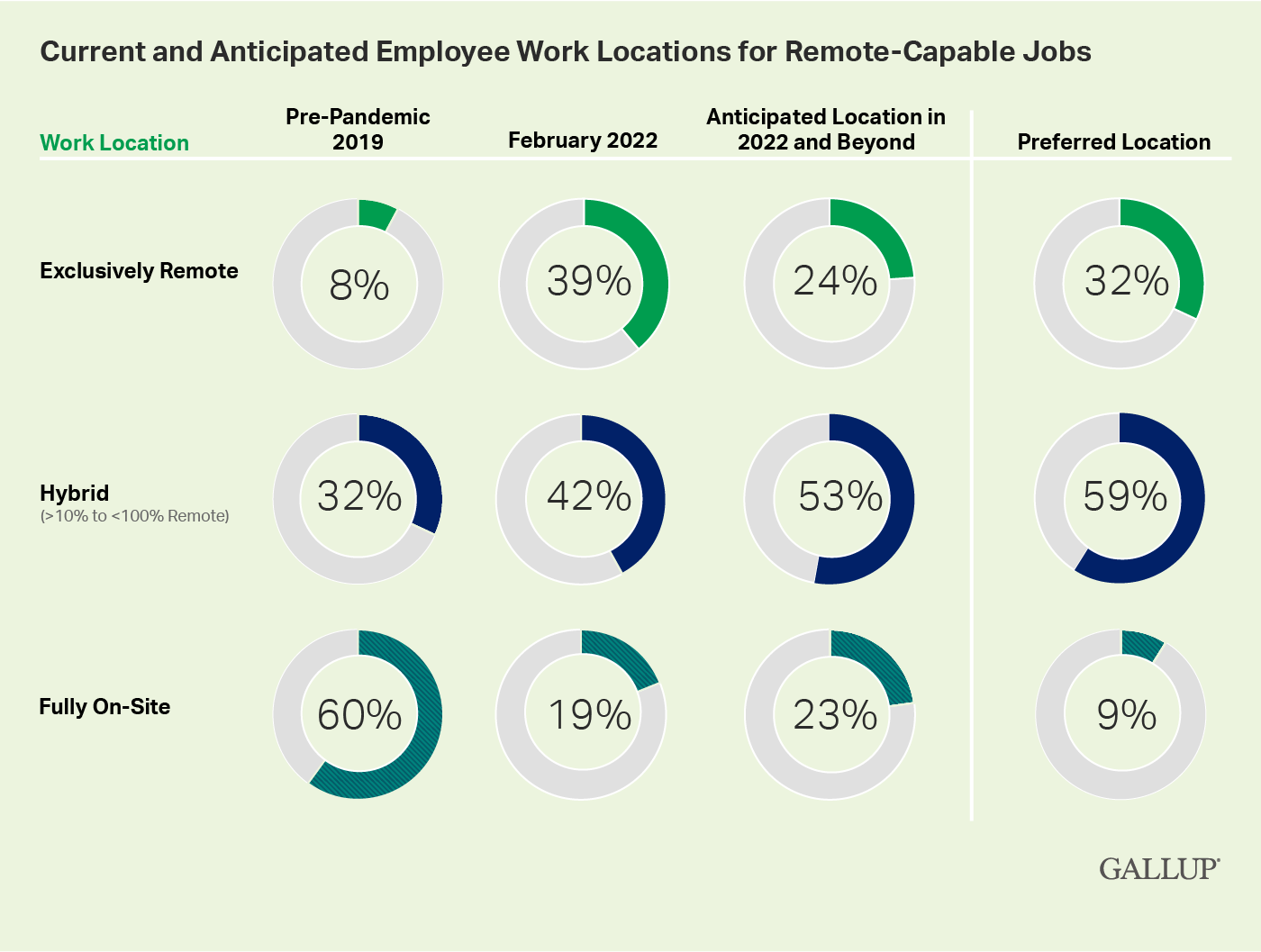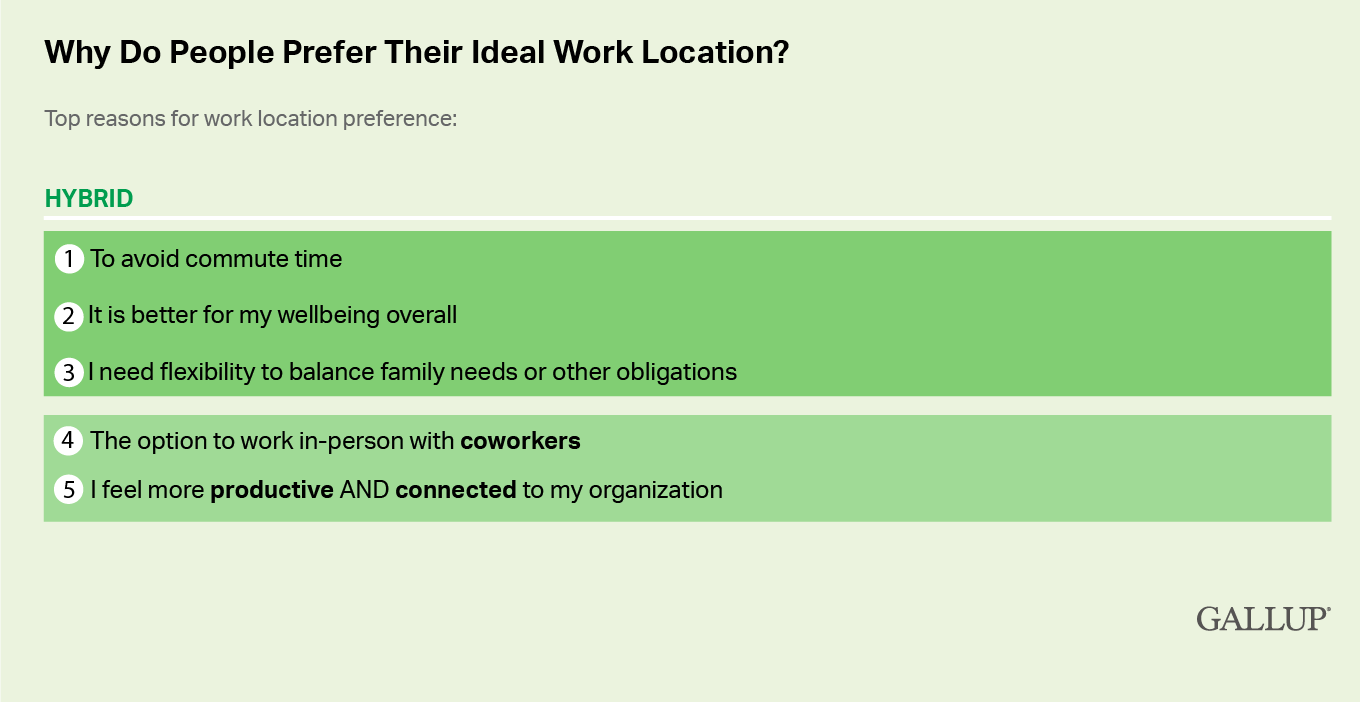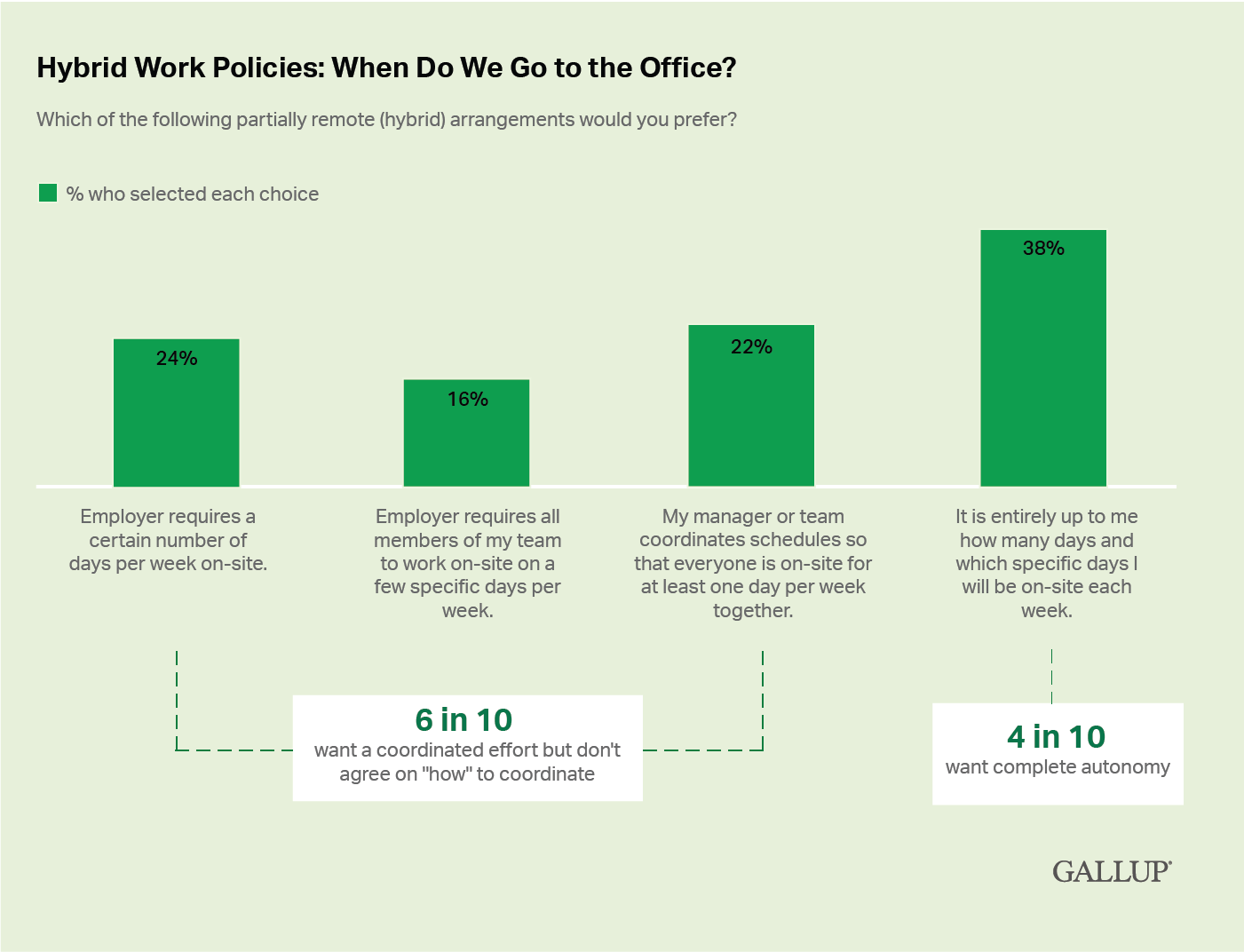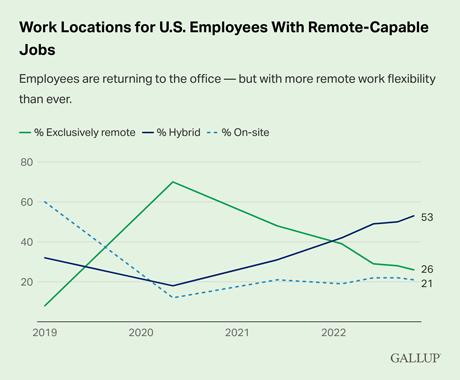Story Highlights
- Hybrid work is the future for most offices
- Failing to offer flexible work arrangements is a risk for organizations
- Hybrid work must be productive and engaging, not just a policy or perk
The past year of COVID-19 variants has thrown a wrench in the return-to-office plan for many organizations. What was expected to be a mass migration back to the office in September of 2021 quickly halted as employers extended their work-from-home policies indefinitely into another miserable pandemic winter. As spring approaches, employees and employers once again are preparing for what their new office environment will look like.
For many employees, returning to the office means some semblance of normalcy -- or at least a workplace more like the one we remember from before the pandemic. Others bristle at the idea of giving up their pajama pants and really good coffee from their kitchen.
But one thing is clear: We're not returning to the same workplace we left. And employees with the ability to work remotely are largely anticipating a hybrid office environment going forward -- one that allows them to spend part of their week working remotely and part in the office.
What exactly hybrid work will look like for each organization is just beginning to take shape, and the ensuing lessons will define our work lives for years to come. Ultimately, how this new hybrid era unfolds will depend on the types of hybrid experiences employers create and how managers adapt.
But one thing is clear: We're not returning to the same workplace we left. And employees with the ability to work remotely are largely anticipating a hybrid office environment going forward.
To help organizations chart their way forward, Gallup has studied the experiences, needs and future plans of more than 140,000 U.S. employees surveyed since the onset of the pandemic. These insights paint a vivid picture of how different offices will be and the unique dynamics of a highly flexible workplace.
Based on our latest insights, Gallup recommends exploring five key questions when transitioning to hybrid work:
- Where are employees working now, and where will they work in the future?
- What happens if organizations do not support remote flexibility?
- Why do many remote-ready employees prefer hybrid work?
- What will the future workweek look like?
- How can we make hybrid work more productive and engaging?
1. Where are employees working now, and where will they work in the future?
Understanding where we're headed begins with reviewing how we got here and what plans exist for the future.
Approximately half of the U.S. full-time workforce -- representing about 60 million workers -- report that their current job can be done remotely working from home, at least part of the time. We refer to these workers as "remote-capable employees."

Current and Anticipated Employee Work Location for Remote-Capable Jobs. 59% prefer hybrid work arrangements going forward.
Before the pandemic, very few remote-capable employees worked exclusively from home (8%), while about one-third had a hybrid work arrangement.
Then the pandemic hit, and the vast majority of remote-capable employees were forced to work from home in some capacity -- as many as 70% worked exclusively from home in May of 2020.
Fast forward to February 2022. Most remote-capable employees continued to work from home at least part of the time, but the mix became a nearly even split -- 42% had a hybrid schedule, and 39% worked entirely from home.
Given the unprecedented number of employees now working hybrid or fully remote, the future of the office is at a turning point. What remote-work options are employers planning? What do employees want?
When asked where they plan to work long term -- according to the plans their employer communicated -- remote-capable employees confirmed that a hybrid work schedule will be the predominant office arrangement going forward. About 53% expect a hybrid arrangement, and 24% expect to work exclusively remotely.
These changes will result in an office environment like we have never seen before, nearly doubling the number of people who will be working remotely at least part of their week (compared with pre-pandemic numbers).
Employees largely like where these changes are headed. Currently, nine in 10 remote-capable employees prefer some degree of remote-work flexibility going forward, and six in 10 specifically prefer hybrid work. Clearly, most employees have developed an affinity for remote-work flexibility that has grown into an expectation for the future. While permanent plans for remote flexibility are certainly trending in their favor, there are still a fair number of employees who will not receive the flexibility they desire.
Key Takeaway:
Remote work is here to stay, and hybrid work is the future for many remote-capable employees.
2. What happens if organizations do not support remote flexibility?
According to our surveys, leaders and managers prefer hybrid work -- and they have considerable hesitation about employees being fully remote. Typically, leaders want to honor the flexibility that employees desire, but they are concerned about sustaining team performance and culture if team members work primarily from home, long-term. For this reason, some leaders may be tempted to restrict remote-work options going forward.
According to our surveys, leaders and managers prefer hybrid work -- and they have considerable hesitation about employees being fully remote.
The long-term effects of mass-scale remote work are yet to be seen. But we know that working from a location that doesn't best suit their needs wreaks havoc on many aspects of employees' lives.
In fact, when employees are required to work fully on-site, but they would prefer to work hybrid or fully remote, employees experience:
- significantly lower engagement
- significantly lower wellbeing
- significantly higher intent to leave
- significantly higher levels of burnout
Naturally, work locations and policies are not the sole determinants of the employee experience. Companies must cultivate thriving workplaces through a holistic and relentless commitment to employee engagement, wellbeing, exceptional managers and a strong company culture.
Nonetheless, attracting and retaining top talent amid today's "Great Reshuffling" of the workforce will require addressing the remote-work question.
In fact, Gallup directly asked workers if they would look for a new job if their employer stopped offering remote-work options going forward. An astounding 54% of employees currently working exclusively from home said they would likely look for another job; 38% of hybrid workers said the same.
Those numbers alone should give pause to any employer not considering some level of remote-work flexibility going forward.
Key takeaway:
Failing to offer flexible work arrangements is a significant risk to an organization's hiring, employee engagement, performance, wellbeing and retention strategies.
3. Why do many remote-ready employees prefer hybrid work?
We asked remote-capable employees who prefer hybrid work why they want this arrangement going forward. And the most common responses were telling.

Why Do People Prefer Their Ideal Work Location? The first reason people prefer hybrid work is to avoid a commute.
The No. 1 reason employees prefer hybrid work is to avoid commute time.
People are not in a hurry to add back the time it takes to get ready for work, travel to the office and return home every day.
The top three reasons employees prefer hybrid work represent a strong desire for more personal freedom to work when, where and how it best suits them. Their demands for better wellbeing, work-life balance and flexibility represent a new "will of the workplace" -- one that won't accept the traditional office going forward.
Employees' fourth and fifth reasons remind us that in our increasingly digital world, they still need to feel connected to their coworkers and their organization. Connecting with their team and feeling that they are part of the company culture is simply easier to experience in person.
It's telling that 38% of fully remote workers would prefer hybrid work. In other words, although fully remote employees enjoy their flexibility, four in 10 would give up some of that time at home to have in-person office experiences.
Overall, the top reasons people want a hybrid work arrangement center on having the flexibility to manage their week while still feeling connected to their organization. These sentiments align with recent Gallup research showing that gaining work-life balance and improved personal wellbeing are top reasons people would change jobs.
Key takeaway:
Hybrid work helps employees get the most out of their day while ensuring they feel connected to coworkers and the organization.
4. What will the future workweek look like?
The most frequent questions we get from leaders and managers about hybrid work are:
- How many days per week should my team come to the office?
- What type of scheduling policies should we have?
To help leaders explore the first question, we asked employees who want hybrid work how many days they would prefer to spend in the office during the typical workweek.

Bar chart showing that 4 in 10 people want to be in the office 2-3 days per week and 3 in 10 want to be in the office 1 or 2 days per week.
Unfortunately for employers, employees don't offer a clear consensus about their preferred remote-to-office ratio. Four in 10 employees want to be in the office two to three days per week -- but that certainly isn't the majority. Another three in 10 employees would prefer spending roughly one or two days in the office each week.
On the upside, most employees agree that a moderate amount of time in the office is important, and Gallup's research has consistently shown that work flexibility tends to be optimal for engaging employees and reducing burnout -- before and during the pandemic.
Nonetheless, employees' preferences on office hours will be an important metric to watch as workplaces transition and adjust to hybrid work.
Additionally, Gallup explored whether employees favor a certain type of hybrid scheduling policy.

Bar chart showing that about four in 10 employees say they want full autonomy to come and go as they wish, and six in 10 want more structure.
Again, there was no clear consensus from employees about how to define hybrid work. About four in 10 employees say they want full autonomy to come and go as they wish, and six in 10 want more structure.
Among those six in 10, there is even less agreement about how to coordinate in-person and remote schedules, with little more than a third of that group agreeing on how to define hybrid for their organization.
Naturally, employees' preferences and the appropriateness of hybrid work schedules vary greatly by organization, team, role and individual. There is no one-size-fits-all answer. What's important is that leaders evaluate which type of guidelines work best for their team, given the type of work they do, support needed and team culture.
About four in 10 employees say they want full autonomy to come and go as they wish, and six in 10 want more structure.
As a starting place, managers should consider how interdependently their team members must work. Highly interdependent teams rely on one another to do work, hand-in-hand, real-time. The more interdependent they are, the more explicit managers must be about when people need to be on-site together, when they need to be available to their teammates, and how handoffs will be handled. These teams require a certain amount of air traffic control and more face-to-face time to keep everything moving cohesively.
Conversely, when people work independently -- doing tasks that require less real-time collaboration -- they can be given more autonomy and flexibility over work schedules because they primarily complete their work individually and asynchronously.
In a hybrid environment, highly independent teams need to double down on communicating, overcommunicating, being accountable for performance outcomes and finding time for team-building. Their biggest risk is working in isolation for too long or at the wrong moments. Highly independent teams also risk culture erosion and the neglect of remote-working coworkers.
While hybrid work schedules should look different by organization and team, it is universally important to keep assessing, adjusting and reassessing how the current arrangement is working.
In the end, employees and organizations alike will need clear answers to why people should come into the office and how they should spend that time together.
Key takeaways:
- There is no consensus among employees on which scheduling policies should define hybrid going forward.
- Setting guidelines based on job responsibilities and continually tracking the effectiveness of these policies will be critical to leading hybrid teams.
5. How can we make hybrid work more productive and engaging?
With so much uncertainty, many organizations are trying to create solid ground for their new normal. Even so, it can be easy for organizations to get bogged down in policies and rules concerning hybrid work. Based on our analysis, the new hybrid workplace needs to provide three things:
- Productivity: Getting the work done efficiently and effectively
- Flexibility: Allowing personalization so people can thrive at work and home
- Connectivity: Encouraging the partnerships that support teamwork and organizational culture
Here are a few of Gallup's recommendations to help leaders stay focused on what's important:
Boost productivity
- Shape hybrid strategies around productivity, not just policy compliance. Now is the time to redefine what high performance looks like for your team and how to best work together to achieve that vision. Ensure you are focused on the right performance outcomes and have the right tools for tracking your progress. Assess which team activities are best on-site and which can be done remotely.
- Consider the interdependency of the work. As previously discussed, when teammates are more interdependent on one another, they need more coordination of schedules and time in person. Many workers are responsible for a mix of interdependent and independent work. These individuals should consider where they can best focus on their individual assignments and when they should be in the office to boost collaboration and team culture.
Boost flexibility
- Allow for flexibility within a framework. There is likely no single hybrid work policy that will be ideal for all teams and all workers. Allowing managers some authority to individualize policies is likely necessary, given the different kinds of work and life circumstances across your organization. It is also necessary to set boundaries for when employees are and are not expected to be available.
- Flexibility and autonomy can create ambiguity and coordination issues. Gallup finds that managers tend to communicate less frequently and effectively when employees spend more time working remotely. However, hybrid team engagement can far exceed on-site engagement when managers proactively check in with their employees multiple times per week. As flexibility increases, managers need to increase communication about work priorities, progress and handoffs between team members.
Boost connectivity
- Think virtual first. When team members working in the office behave as if everyone is working remotely, remote workers are more likely to feel like part of the team. For example, bringing laptops to all meetings so everyone has an on-screen presence can create a more inclusive experience. Also, taking time to learn together is a great way to grow into a hybrid team. Try scheduling training that teaches your team to collaborate more effectively in a virtual setting.
- Give people a compelling reason to come to the office. A policy is not an answer to why people should come to the office. Leaders need to develop a compelling workplace value proposition that represents the culture, benefits and interactions employees will experience on-site.
The hybrid future: Challenges and promise
Saying your company is a hybrid workplace is much easier than creating an effective one. Without a doubt, hybrid work will be more challenging for managers than their old ways of working. Flexibility for workers makes coordination difficult. Remote workers can feel neglected. Technology requirements must change. And hybrid work raises questions of trust, accountability and measuring productivity -- even equity and access to hybrid opportunities.
"Hybrid" is not just a work schedule or employee perk -- it's an entirely new way of working together.
Crafting an exceptional hybrid work experience will be worth it -- if you put in the hard work to make it worth it. We have already seen the benefits for those who did it before the pandemic and are living it today. Exceptionally led hybrid teams tend to have more engaged employees, more intentional and meaningful interactions, and, ultimately, better flexibility to integrate work and home life.
Looking forward, all signs indicate that hybrid is fast becoming a new expectation of the workforce. The next chapter of this great global work experiment will be written by how employers respond to the opportunities and challenges afforded by two years of learning to work differently.
Check out these resources to help you navigate the "new normal" of hybrid work:
- Read our comprehensive resource, Managing Remote Teams While Maintaining Company Culture, to learn about building a positive and productive working environment outside of the office.




